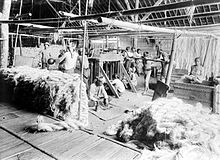Manila hemp

Manila hemp, also known as abacá, is a type of buff-colored fiber obtained from Musa textilis (a relative of edible bananas), which is likewise called Manila hemp[1] as well as abacá. It is mostly used for pulping for a range of uses, including speciality papers. It was once used mainly to make Manila rope,[2] but this is now of minor importance. Abacá is an exceptionally strong fibre, nowadays used for special papers like teabag tissue. It is also very expensive, priced several times higher than woodpulp. Manila envelopes and Manila paper take their name from this fibre.[3][4]
It is not actually hemp, but named so because hemp was long a major source of fibre, and other fibres were sometimes named after it. The name refers to the capital of the Philippines, one of the main producers of Manila hemp.[3][4] The hatmaking straw made from Manila hemp is called tagal or tagal straw.[5][6]
Diversity[]
The Philippines, especially the Bicol region in Luzon, has the most Manila hemp or abaca genotypes and cultivars. Genetic analysis using simple sequence repeats (SSR) markers revealed that the Philippines' abaca germplasm is genetically diverse.[7] Abaca genotypes in Luzon had higher genetic diversity than Visayas and Mindanao.[7] Ninety-five (95) percent was attributed to molecular variance within the population, and only 5% of the molecular variance to variation among populations.[7] Genetic analysis by Unweighted Pair Group Method with Arithmetic Mean (UPGMA) revealed several clusters irrespective of geographical origin.[7]
See also[]
References[]
- ^ "Musa textilis". Germplasm Resources Information Network (GRIN). Agricultural Research Service (ARS), United States Department of Agriculture (USDA). Retrieved 5 June 2014.
- ^ "Manila hemp". Transport Information Service, Gesamtverband der Deutschen Versicherungswirtschaft e.V. Retrieved May 15, 2011.
- ^ Jump up to: a b H. T. Edwards; B. E. Brewer; George E. Nesom; Otis Warren Barrett; William Scrugham Lyon & Murad M. Saleeby (1904). "Abacá (manila hemp)". Farmers' Bulletin. Bureau of Agriculture. Republic of the Philippines.
- ^ Jump up to: a b Katrien Hendrickx (1904). "The Origins of Banana-fibre Cloth in the Ryukyus, Japan". Farmers' Bulletin. Studia anthropologica. Leuven University Press. 11: 170. ISBN 978-90-5867-614-6.
- ^ Dreher, Denise (1981). From the neck up : an illustrated guide to hatmaking (1st ed.). Minneapolis, Minn.: Madhatter. ISBN 9780941082006.
- ^ Ginsburg, Madeleine (1990). The hat: trends and traditions (1st U.S. ed.). Hauppauge, N.Y.: Barron's. ISBN 9780812061987.
Tagal.
- ^ Jump up to: a b c d Yllano, O. B., Diaz, M. G. Q., Lalusin, A. G., Laurena, A. C., & Tecson-Mendoza, E. M. (2020). "Genetic Analyses of Abaca (Musa textilis Née) Germplasm from its Primary Center of Origin, the Philippines, Using Simple Sequence Repeat (SSR) Markers – The Philippine Agricultural Scientist". Retrieved 2021-02-16.CS1 maint: multiple names: authors list (link)
External links[]
| Wikisource has the text of the Encyclopædia Britannica (9th ed.) article Manila Hemp. |
- Musaceae
- Fiber plants